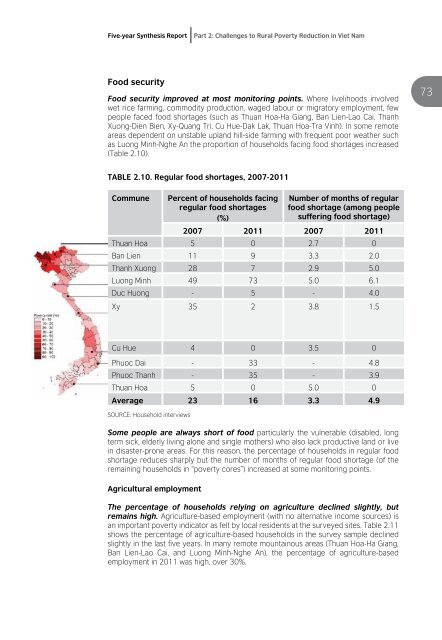Challenges to Rural Poverty Reduction in Viet Nam - Oxfam Blogs
Challenges to Rural Poverty Reduction in Viet Nam - Oxfam Blogs
Challenges to Rural Poverty Reduction in Viet Nam - Oxfam Blogs
You also want an ePaper? Increase the reach of your titles
YUMPU automatically turns print PDFs into web optimized ePapers that Google loves.
Five-year Synthesis Report<br />
Part 2: <strong>Challenges</strong> <strong>to</strong> <strong>Rural</strong> <strong>Poverty</strong> <strong>Reduction</strong> <strong>in</strong> <strong>Viet</strong> <strong>Nam</strong><br />
Food security<br />
Food security improved at most moni<strong>to</strong>r<strong>in</strong>g po<strong>in</strong>ts. Where livelihoods <strong>in</strong>volved<br />
wet rice farm<strong>in</strong>g, commodity production, waged labour or migra<strong>to</strong>ry employment, few<br />
people faced food shortages (such as Thuan Hoa-Ha Giang, Ban Lien-Lao Cai, Thanh<br />
Xuong-Dien Bien, Xy-Quang Tri, Cu Hue-Dak Lak, Thuan Hoa-Tra V<strong>in</strong>h). In some remote<br />
areas dependent on unstable upland hill-side farm<strong>in</strong>g with frequent poor weather such<br />
as Luong M<strong>in</strong>h-Nghe An the proportion of households fac<strong>in</strong>g food shortages <strong>in</strong>creased<br />
(Table 2.10).<br />
73<br />
TABLE 2.10. Regular food shortages, 2007-2011<br />
Commune<br />
Percent of households fac<strong>in</strong>g<br />
regular food shortages<br />
(%)<br />
Number of months of regular<br />
food shortage (among people<br />
suffer<strong>in</strong>g food shortage)<br />
2007 2011 2007 2011<br />
Thuan Hoa 5 0 2.7 0<br />
Ban Lien 11 9 3.3 2.0<br />
Thanh Xuong 28 7 2.9 5.0<br />
Luong M<strong>in</strong>h 49 73 5.0 6.1<br />
Duc Huong - 5 - 4.0<br />
Xy 35 2 3.8 1.5<br />
Cu Hue 4 0 3.5 0<br />
Phuoc Dai - 33 - 4.8<br />
Phuoc Thanh - 35 - 3.9<br />
Thuan Hoa 5 0 5.0 0<br />
Average 23 16 3.3 4.9<br />
SOURCE: Household <strong>in</strong>terviews<br />
Some people are always short of food particularly the vulnerable (disabled, long<br />
term sick, elderly liv<strong>in</strong>g alone and s<strong>in</strong>gle mothers) who also lack productive land or live<br />
<strong>in</strong> disaster-prone areas. For this reason, the percentage of households <strong>in</strong> regular food<br />
shortage reduces sharply but the number of months of regular food shortage (of the<br />
rema<strong>in</strong><strong>in</strong>g households <strong>in</strong> “poverty cores”) <strong>in</strong>creased at some moni<strong>to</strong>r<strong>in</strong>g po<strong>in</strong>ts.<br />
Agricultural employment<br />
The percentage of households rely<strong>in</strong>g on agriculture decl<strong>in</strong>ed slightly, but<br />
rema<strong>in</strong>s high. Agriculture-based employment (with no alternative <strong>in</strong>come sources) is<br />
an important poverty <strong>in</strong>dica<strong>to</strong>r as felt by local residents at the surveyed sites. Table 2.11<br />
shows the percentage of agriculture-based households <strong>in</strong> the survey sample decl<strong>in</strong>ed<br />
slightly <strong>in</strong> the last five years. In many remote mounta<strong>in</strong>ous areas (Thuan Hoa-Ha Giang,<br />
Ban Lien-Lao Cai, and Luong M<strong>in</strong>h-Nghe An), the percentage of agriculture-based<br />
employment <strong>in</strong> 2011 was high, over 30%.

















